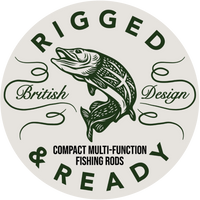START FISHING GUIDE 3/3 "Setting up your rod, casting and knots to use"
So... Part 3 of the things you need to know to get fishing. Setting up your rod, casting and knots.

GOOD TECHNIQUE. OBVIOUSLY A GOOD TEACHER!
1. ROD SET UP
Assembling the rod together properly, extends its life. *
-
Put the rod sections in size order from handle to tip.
-
Bring the size matching ferrules together carefully.
-
Push the ferrules together, twisting the rod to line up the guides.
-
The line can now travel smoothly along the ferrules.

2. KNOW THE REEL *
• REEL FOOT. Fixes to the rod handle, using a screw thread on the rod.
• HANDLE. Can be left or right handed. When turning forwards the line winds in.
• LINE SPOOL. This holds the fishing line. The line must be tied to the line spool.
• LINE ROLLER. Line runs from the spool under the roller, then down the rod guides.
• BAIL ARM. Locked open in casting, then automatically returns to wind in the line.
• ANTI REWIND. When locked on it prevents the reel winding backwards.
• DRAG ADJUSTMENT. Ensures the line from the reel will pull out before breaking.

3. FIXING REEL & ROD
• Place the foot of the reel in the reel seat on the rod handle.
• Secure it by screwing the screw on the handle towards the reel foot • Ensure it is firm, but do not over tighten.

4. ATTACHING LINE
-
Open the bail arm.
-
Place the line around the reel spool.
-
Tie a suitable tight knot of your choice with the line tightly round the spool.
-
Cut the loose piece of line so the knot is secure.
-
Close the bail arm.
-
Tightly hold the line 50cm (1 foot) away from the reel.
-
Keep the line tight, turning the reel handle until the line is on the reel, ensuring the line comes just under the edge of the line spool to make casting easier.
-
Now open the bail arm and thread the line through the fishing guides.

5. ALMOST READY TO FISH
-
Now tie on your hook, lure, or terminal tackle (hook and weight/sinker)
-
There are 100’s of knots for tackle. Here are 2 that cover every need.


- Now the tackle will fly, taking line off the spool until it hits the water (you will need to practice this to get the timing*).
- Now set the line drag properly so the line does not break, and you are ready to cast. The drag is on the front or back of the reel. It can be tightened or loosened to allow line to run off the reel, even with the bail arm still attached.
* You can learn the overhand cast, sidearm, underarm, flipping, and skip cast. (You will learn with practice)
6. PRACTICE THE CAST
-
Hold the reel with your dominant hand at the reel foot, where it joins the rod.
-
Ensure your index finger can reach just above the bail arm. (Picture 1)
-
Move the bail arm so the line roller and line are close to your index finger.
-
Using your index finger, wrap it around the line with the bail arm still closed.

INDEX FINGER CAN REACH PULL THE LINE OFF THE LINE WITH YOUR OTHER HAND THE LINE ROLLER ROLLER WITH INDEX FINGER OPEN THE BAIL ARM
-
Check the tackle at the end of the line is not touching the rod tip or there isn’t too much line away from the tip (50cm is ideal between the tackle and the rod tip).
-
With your index finger still holding the line, flip open the bail arm (Letting go of the line is going to let it leave the spool).
-
Facing forwards, draw the rod slowly back behind you.
-
Swing the rod forward faster, releasing the line from your index finger, when the rod is almost in front of you.
LOOK AFTER YOUR FISH
To fish responsibly you should also have a hook disgorger, scissors, forceps a landing net and hand towel.
Remember all hooks should be barbless to ensure fish can be returned safely.
THE END
WE TOLD YOU IT WAS A BASIC GUIDE }<(((*>






